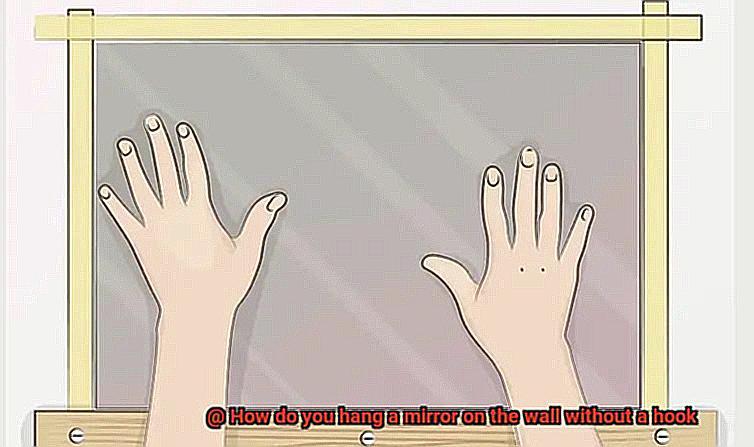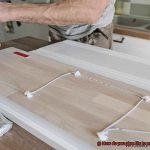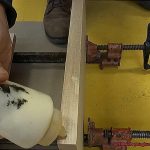Ready to defy gravity and unleash your inner design guru? Imagine a stunning mirror gracing your wall, radiating elegance and sophistication, all without a single hook in sight. Intrigued? You should be.
Hanging a mirror on the wall is a timeless way to add depth, style, and functionality to any space. But what if you lack the conventional hardware? Fear not. We’ve got some tricks up our sleeves. In this blog post, we’ll explore the fascinating art of hanging a mirror without a hook.
So, how can you gift your walls with mirrors without poking holes in them? Let’s dive right in.
Adhesive Strips and Mounting Squares:
Contents
- 0.1 Adhesive Strips and Mounting Squares:
- 0.2 Mounting Putty:
- 0.3 Picture Rail Hooks:
- 0.4 Tension Rods:
- 0.5 Decorative Rope or Wire:
- 1 Adhesive Hooks or Mounting Strips
- 2 Adhesive Putty or Glue
- 3 Mechanical Methods: Mirror Clips and Brackets
- 4 Preparing the Wall Surface
- 5 Weight and Size Considerations
- 6 Adhesive Strength Requirements
- 7 Avoiding Gaps or Unevenness
- 8 Conclusion
Revolutionary adhesive strips and mounting squares are changing the game. These remarkable sticky wonders provide a secure hold while leaving no trace when removed. Perfect for renters or those hesitant about traditional hooks.
Mounting Putty:
Looking for a temporary solution? Meet your new best friend – mounting putty. This moldable and reusable adhesive creates a sturdy bond, allowing effortless experimentation with various mirror placements.
Picture Rail Hooks:
Who says hooks are the only option? Picture rail hooks offer classic gallery-like appeal to your mirror display. Slim and discreet, they can be attached to picture rails or seamlessly incorporated into existing molding for that floating effect.
Tension Rods:
Versatility at its finest. Tension rods work wonders for mounting mirrors without damaging walls. Simply extend the rod within the desired space and create a snug fit for secure mirror placement.
Decorative Rope or Wire:
For rustic charm enthusiasts, consider using decorative rope or wire to hang your mirror. Embrace your creativity by fashioning unique knots, braids, or elegant twists – turning your mirror installation into an art piece itself.
Now that you know the possibilities of hanging a mirror without a hook, get ready to elevate your interior design game. With these innovative solutions, not only will you enhance your space, but you’ll also reinvent the way mirrors can be showcased.

So, what are you waiting for? Unleash your wall’s potential by comfortably suspending those mirrors without a single hook in sight.
Adhesive Hooks or Mounting Strips
Adhesive hooks and mounting strips are here to save the day. In this comprehensive guide, we will delve into the wonderful world of these innovative alternatives, exploring their advantages, considerations, and step-by-step installation tips.
Advantages of Adhesive Hooks:
- Effortless Installation: Peel off the backing, press firmly onto the wall, and voila. Adhesive hooks make hanging mirrors a breeze, requiring no tools or additional hardware.
- Versatile Options: From sleek and minimalistic designs to sturdy and decorative hooks, adhesive hooks come in various sizes and styles to suit your mirror and aesthetic preferences.
- Damage-Free Removal: When it’s time for a change or relocation, adhesive hooks can be easily peeled off without leaving any residue or causing unsightly wall damage.
- Secure Weight Support: Select adhesive hooks with a weight capacity higher than your mirror’s actual weight for added peace of mind.
Advantages of Mounting Strips:
- Unparalleled Stability: Larger and heavier mirrors find their perfect match in mounting strips. With two interlocking pieces, these strips provide enhanced stability that ensures your mirror stays firmly in place.
- Even Weight Distribution: Worried about sagging or tilting? Mounting strips evenly distribute the weight of your mirror, eliminating these concerns and adding extra stability.
- Damage-Free Removal: Just like adhesive hooks, mounting strips can be removed without a trace, preserving your wall’s integrity.
- Surface Versatility: Whether you have painted walls, glass, or tiles, mounting strips are compatible with various surfaces, giving you more flexibility in choosing where to hang your mirror.
Adhesive Putty or Glue
Transforming your living space with beautiful mirrors doesn’t have to involve drilling holes in your walls. Thanks to the wonders of adhesive putty and glue, hanging mirrors has become a breeze. In this comprehensive guide, we will delve into the nuances of these two options and help you choose the perfect one for your mirror-hanging endeavors.
Adhesive Putty: Sticky, Moldable, and Reusable
Adhesive putty is an incredible solution for effortlessly hanging lightweight mirrors. Its remarkable sticky and moldable properties make it a joy to work with. Here are some key points to consider:
- Reusability: Adhesive putty’s greatest advantage lies in its reusability. Say goodbye to residue and wall damage; you can remove and reuse it multiple times without any hassle.
- Weight Capacity: While adhesive putty excels in supporting lightweight mirrors, it may not be suitable for heavier or larger ones that require more stability and support.
- Application Technique: To hang a mirror using adhesive putty, roll a small piece into a ball between your palms until it becomes soft and pliable. Apply gentle pressure as you press the putty strategically onto the back of the mirror, ensuring excellent contact with both the mirror and the wall. Remember to strategically place the adhesive putty at several points along the edges and center to provide adequate support.
Glue: Forming a Strong Bond for Permanent Attachment
For those seeking a more permanent solution, glue offers a sturdy attachment when it dries. Here’s what you need to know about using glue:
- Permanence: Glue creates an unyielding bond between the mirror and the wall surface, ensuring long-lasting stability. However, it’s important to note that removing the mirror in the future may require more effort and care.
- Weight Capacity: Glue is your go-to option for hanging heavier mirrors. Ensure you select a glue specifically designed for hanging objects on walls to guarantee a secure bond.
Mechanical Methods: Mirror Clips and Brackets
In our quest for innovative mirror hanging methods, we have explored the wonders of adhesive putty and glue. Today, we embark on a thrilling journey into the mechanical realm of mirror clips and brackets. These robust solutions offer a secure way to hang your mirrors without the need for a hook. Get ready to dive into the world of different types, installation techniques, and how to choose the perfect one for your mirror.
Mirror Clips: Small Yet Mighty
Enter the unsung heroes of the mirror-hanging world – mirror clips. Don’t let their small size deceive you; these unassuming brackets possess incredible strength. Crafted from metal or plastic, they attach to the back of your mirror before being firmly secured to the wall using screws or adhesive.
Installing these mighty clips couldn’t be easier. Simply position them evenly on each side of your mirror’s frame. For larger or uniquely shaped mirrors, it’s advisable to use multiple clips for enhanced stability. Once in place, these clips lock your mirror in position, ensuring it stays put without any sliding or perilous falls.
Mirror Brackets: Heavy-Duty Guardians
When faced with the challenge of hanging larger or heavier mirrors, fear not. Mirror brackets come to the rescue as your trusty heavy-duty support system. These robust metal warriors guarantee unparalleled strength and unwavering stability. Consisting of two parts – one attached to the wall and the other to the back of your mirror – they provide a formidable fortress for your precious reflective companion.
To install these mighty brackets, commence by securely affixing one part to the wall using screws. Next, align the corresponding part on the back of your mirror and join them together with a satisfying click. Behold. Your mirror is now triumphantly mounted on the wall, ready to dazzle all who encounter its splendor.
Selecting the Perfect Clip or Bracket:
With an array of options at your fingertips, it’s essential to select the ideal clip or bracket for your unique mirror. Consider these factors in your quest for perfection:
Weight Capacity: Different clips and brackets possess varying weight capacities. Choose one that can confidently bear the weight of your mirror. Opting for a clip or bracket with a higher weight capacity than anticipated ensures unwavering security.
Preparing the Wall Surface
Step 1: Cleanse the Wall – A Fresh Start
Before our masterpiece takes shape, we must cleanse our canvas from the clutches of dust and debris. With a damp cloth in hand, wipe down the wall, leaving behind only pristine purity. A clean surface sets the stage for perfection.
Step 2: Vanishing Hooks and Nails – Clearing the Path
Now that our canvas is immaculate, we must bid farewell to any lingering hooks or nails. With pliers and screwdriver as our allies, we meticulously remove these remnants of the past. A blank space awaits our mirror’s grand debut.
Step 3: Smoothing Imperfections – Flawless Elegance
Every masterpiece deserves a flawless canvas. Inspect the wall for imperfections – bumps, cracks, or unsightly holes. Armed with a putty knife or spackling compound, fill these blemishes and let them dry until perfection is achieved. Sand them down until they become one with the wall’s surface.
Step 4: Painting Perfection – A Touch of Artistry
If paint has graced your wall recently, it’s time for a discerning eye. Hunt for any fading or chipped areas and wield your matching paint like a maestro. Cover those imperfections with grace and precision. Patience is key as we allow our strokes to dry into seamless unity.
Step 5: The Perfect Placement – Where Mirrors Dance
The climax approaches as we determine the mirror’s rightful abode on the wall. Height, alignment, and visibility become our guiding stars. Step back and envision the mirror’s enchanting presence, lightly marking the chosen spot with a pencil. The stage is set for a captivating performance.
Conclusion:
Congratulations, fellow mirror enthusiasts. With these meticulous steps, you have crafted a rock-solid foundation for your mirror installation without a hook. Preparing the wall surface is akin to an artist laying the groundwork for their masterpiece, ensuring stability and elevating aesthetics.
Weight and Size Considerations
Today, we embark on a journey filled with intrigue and enchantment, unlocking the secrets that will ensure your mirror stays securely mounted on the wall without a hook. Let’s delve into the fascinating realm of weight and size considerations.
Understanding the Weight:
Before we dive into the depths of mirror hanging, it is crucial to unravel the mystery of its weight. Seek the knowledge hidden in the packaging or consult the mirror’s manufacturer to discover this vital information.
Why is this knowledge so important, you may wonder? Well, understanding the weight empowers you to select the perfect adhesive or mounting method tailored to your unique mirror.
For Lighter Mirrors:
If your mirror is as light as a feather, a small decorative wonder, adhesive hooks or strips may be your trusty companions. These remarkable creations are designed to bear specific weights and can be easily attached to your wall without inflicting damage.
But remember, heed the manufacturer’s instructions diligently and ensure the adhesive possesses enough strength to support your mirror’s weight.
When Size Matters:
Now let us turn our attention to mirrors grand in stature and weight. Adhesive hooks alone may not possess the strength required to hold these magnificent specimens securely. In such instances, we must explore alternative methods like brackets or anchor screws.
Brackets become our allies, providing additional support by cradling the mirror from both sides, distributing its weight evenly and alleviating strain on the adhesive. Conversely, anchor screws plunge into the wall, forging an unyielding anchor point for a truly secure attachment.
The Art of Distribution:
In this wondrous realm of mirrors, size is not the sole consideration; distribution holds equal sway. Larger mirrors demand multiple hooks or brackets, their presence ensuring stability and warding off potential hazards. Remember, my friends, the secret lies in even weight distribution along the back of the mirror, aligning its reflections with utmost precision.
Adhesive Strength Requirements
In our pursuit of securely mounting mirrors on walls without hooks, we now venture into the intricate world of adhesive selection. So, grab your favorite mirror and let us embark on this exhilarating journey together.
Factors to Consider When Selecting an Adhesive:
Weight of the Mirror:
Just like us humans, mirrors come in a plethora of shapes and sizes. Imagine the horror of an adhesive that cannot bear the weight of your mirror. Before making a decision, it is vital to consider the weight of your mirror and ensure you choose an adhesive with a manufacturer-specified weight limit. Let’s avoid any unexpected crashes, shall we?
Type of Wall Material:
Ah, the foundation upon which our mirrors rely. Different wall materials demand specific adhesives for optimal bonding. Whether it be drywall, concrete, or tile, selecting an adhesive that harmonizes with your wall material guarantees a steadfast and enduring bond between your mirror and its new home.
Size and Shape of the Mirror:
Size does matter when it comes to mirror hanging. Larger mirrors may necessitate robust adhesives or multiple attachment points to distribute weight evenly. We certainly don’t want any wobbly mirrors stealing the show. Additionally, irregularly shaped mirrors warrant specialized adhesives or additional support to ensure their unwavering presence on the wall.
Environmental Factors:
Ah, nature’s impact on our beloved mirrors. Our environment can be a formidable adversary. Beware high humidity levels, extreme temperatures, and moisture-prone areas that can weaken adhesive bonds. To conquer these challenges, opt for an adhesive boasting resilience against such conditions. Let’s protect our mirrors from Mother Nature’s whims.
In the realm of hanging mirrors without hooks, adhesive strength requirements reign supreme. By considering the weight of your mirror, the type of wall material, the size and shape of your mirror, and environmental conditions, you can select the adhesive that will firmly hold your mirror in place.
With this newfound knowledge, my dear mirror enthusiasts, go forth confidently and choose the adhesive that best befits your mirror’s needs. Bid farewell to unsteady mirrors and embrace a world of secure and stylish reflections.
May your mirror hanging endeavors be filled with success and satisfaction.
Avoiding Gaps or Unevenness
In our previous expedition, we unlocked the secrets of mounting mirrors without hooks. Now, let’s embark on a captivating journey to conquer the challenge of avoiding gaps or unevenness when hanging a mirror. No one wants a lopsided reflection, so let’s uncover the thrilling tricks and techniques to achieve a level and seamless installation.
The Marvels of Adhesive Strips and Mounting Tapes:
When it comes to achieving a flawless mirror installation, adhesive strips and mounting tapes become your trusty allies. These remarkable inventions provide a strong and secure hold, eliminating the need for unsightly hooks or nails. Brace yourselves as we unveil the steps to perfection:
- The Power of Purity: Before applying adhesive strips or mounting tapes, ensure that the wall surface is spotless. Dust, dirt, or grease can impede their adhesive prowess. Wipe down the intended area with a mild detergent or cleaning solution.
- A Dance with Instructions: Each adhesive product has its own set of instructions. Honor them diligently and select a product appropriate for your mirror’s weight. Never underestimate the power of a well-read instruction manual.
- Embrace Symmetry with a Level Tool: To achieve an even installation that will make your heart skip a beat, enlist the aid of a trusty level tool. Place it atop the mirror and adjust until both bubbles rest in their centered sanctuary. This will ensure your mirror stands tall in perfect horizontal and vertical alignment.
Weight Distribution: Conquering Larger Mirrors:
Fear not if you’re faced with the challenge of mounting a larger or heavier mirror. We have just the solution to maintain equilibrium and banish gaps or sagging in the middle. Consider employing multiple adhesive strips or mounting tapes to distribute the weight evenly across your mirror’s back. This superhero move will result in a secure and visually captivating installation.
The Charm of Clear Silicone Adhesive:
For those seeking to elevate their mirror installation prowess, clear silicone adhesive is here to work wonders. This versatile adhesive conquers various surfaces, including glass, tiles, and painted walls. Let’s unravel the steps to a breathtaking finish:
Conclusion
In conclusion, don’t limit yourself when it comes to hanging a mirror on the wall without a hook. Get creative and explore the endless possibilities that await you. Say goodbye to boring hooks and hello to innovative alternatives that will not only secure your mirror but also enhance your style.
Adhesive strips and mounting squares are your new best friends. They offer an effortless installation process with no damage to your walls. Perfect for renters or those who prefer a non-committal approach, these options leave no trace when removed.
If you’re looking for a temporary solution that allows for easy experimentation, mounting putty is the way to go. Moldable and reusable, it gives you the freedom to play around with mirror placements until you find the perfect spot.
For a touch of elegance, consider picture rail hooks. They add a classic gallery-like appeal to your mirror display, elevating the overall look of any space. If versatility is what you’re after, tension rods are your secret weapon. With their ability to create a snug fit within any desired space, they offer endless possibilities for showcasing your mirrors.
But why stop there? Let’s add some rustic charm into the mix with decorative rope or wire. Not only do they provide a secure hold for your mirrors, but they also allow for creative knotting and braiding techniques that will leave everyone in awe.
Of course, stability is key when hanging mirrors without hooks. Take into consideration the weight and size of your mirror, as well as the type of wall material you’re working with. Environmental factors should also be considered when choosing adhesive strength requirements.
So let’s break free from traditional hooks and embrace a world of creativity and style. With these tips and techniques in mind, you can confidently hang mirrors on your walls without hooks while adding depth, personality, and functionality to any space.






